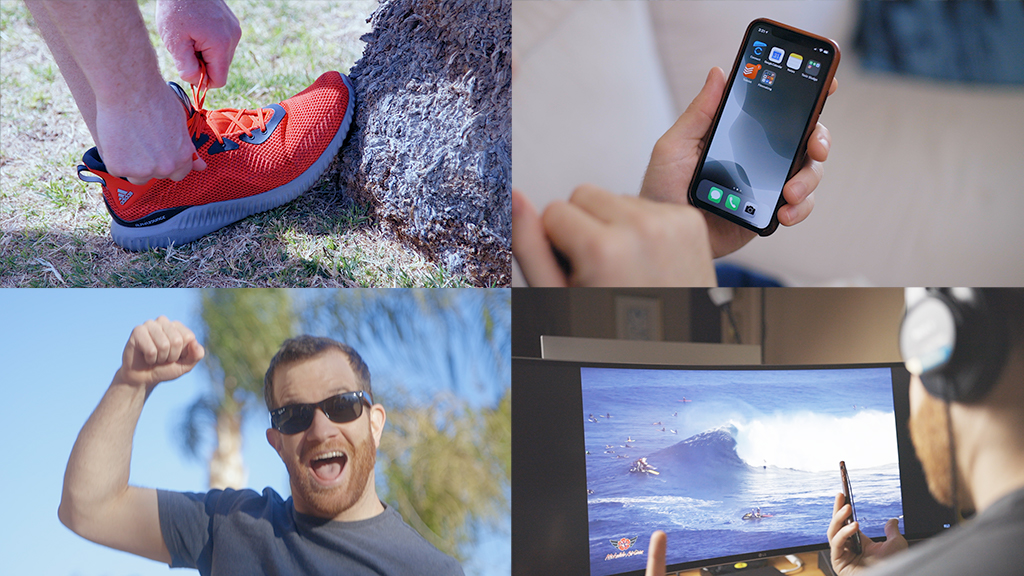
Back in 2014, I started noticing something strange. Every day, there were small things I’d do that I often didn’t even realize were happening. And although small, I couldn’t help but notice the compounding effect those small things were making in my life. It was the result of the four most common Twitches adding up to create a massive impact.
These tiny unintentional actions I was taking would temporarily solve the discomfort I was feeling. I’d wish I were more physically fit, and ‘Click’ I’d order some running shoes. Procrastinating on a writing project? ‘Tap’ on the Instagram app. The more I started paying attention, the more I saw these Twitches literally everywhere.
A one-click workout tracker purchase that would surely start my workout habit this time. (It didn’t).
A quick Instagram check mere seconds after just closing the app. (Still nothing to see there).
Pulling out my phone one millisecond after my lunch date got up from the table to go to the bathroom. (As if I could hardly wait for them to leave so I could check on the rest of the world).
Taking out my iPhone and, without thinking, opening the Facebook app while looking at Facebook on the laptop in front of me. (Double yikes).
The immediate, enthusiastic, “Yes!” to commitments I didn’t have the time or space for because at some deep level, not being liked is uncomfortable. (People-pleasers unite!)
A new super exciting project idea that conveniently comes up when an existing project starts getting difficult. I can’t help but leap over and start the exciting learning curve part all over again. (While leaving yet another thing unfinished).
While all of these scenarios are different, they’re all in the category of what I call, “The Twitch.”
These common Twitches pacify our tiny discomforts during the day with impulsive, unproductive solutions.
This is problematic because these non-life-threatening discomforts are our biggest growth opportunities as human beings. When we succumb to them instead of facing the discomfort, we lease out our attention for the benefit (and profit) of others—mostly, billion and trillion-dollar corporations.
And what do we get back for this attention we freely give away? Some temporary comfort from momentary discomfort.
Since that fateful office interruption in 2014 that changed my life, I’ve been working to understand why these distractions are so darn appealing, and what we can do to Break the Twitch and truly own our attention again.
The Four Most Common Twitches
While all of them are different, there are overlapping elements across the four most common Twitches.
The Newsfeed Twitch
An addiction to anything and everything new. An article in the New York Times. A new front page on Reddit. A reshuffled feed on Instagram. An alert. A text message. The latest email in your inbox.
We crave the quick hit of dopamine from something new being available for us. And there always will be something new; always. It’s the internet, not a newspaper.
The New Twitch is exacerbated by notifications and the constant access we allow through the smartphones that almost leave our side. If you struggle to sit and watch the world go by while you wait for a friend to arrive at your meeting place, it’s probably because of this Twitch.
The False First Step Twitch
The one-click purchase that feels like a step toward something we want to accomplish, but it ends up gathering dust in the closet. The yoga mat. The personal development book. The athleisure-wear. The guitar.
The False First Step can also take the form of talking about your intentions or sharing what you’re going to do with a friend. Sometimes saying it feels good enough that you don’t actually end up doing it—unless they help you stay accountable. If this is a consistent pattern that exists in your life, it’s the False First Step Twitch.
Habits are the foundation of what we do and who we are, but habits are, well, hard. Talking about it or buying stuff, on the other hand, is easy. Especially when it comes to buying stuff online. With one click of the mouse or a tap of the finger, we trick our brains into feeling like we took a step toward our goals. We get to be excited again when it arrives in the mail.
But nothing changes, except maybe our credit card balances (ouch).
The False First Step Twitch is exacerbated by instant access to just about anything we could possibly want, delivered within two to forty-eight hours. The effort required is so little, that it’s practically effortless.
The Yes Twitch
The Yes Twitch is when we say, “Yes” to requests or commitments that we don’t actually have time for or want to do. This is because the confrontation of saying, “No” is a form of discomfort we aim to avoid. That, and well, we want people to like us. Or it might be an exciting shiny new object (see below).
It’s human nature to not want to disappoint the people we love and seek approval from. Without proper boundaries in place, we over-commit ourselves in ways that aren’t beneficial. This doesn’t mean you don’t help out a friend or do things for other people. Nor does it mean not saying “Yes” to great opportunities. It’s more about the things that in our gut, we know aren’t good uses of our time but we say, “Yes” anyway.
It’s much easier to say “Yes” now, and deal with it later than it is to create an uncomfortable situation by saying “No” right away. There might be social pressure, such as the Fear Of Missing Out (FOMO) that pressures us into this circumstance as well.
The Shiny New Object Twitch
When things get boring or difficult, this Twitch steals our attention away for another, new, and more exciting pursuit. This is like a 30-acre property full of unlivable, half-constructed houses. It’s a plethora of new ventures and projects, many dropped balls and little follow-through.
It’s great to try new things and experiment, but only if we have the space needed to give it our full attention. Starting something new periodically isn’t necessarily a Twitch. Nor is trying something new and learning it’s not for you. The Shiny New Object Twitch is if there’s a pattern of starting many things, not finishing, then jumping to something different once the initial exciting newness simmers down.
Take a look back on commitments you’ve made over past months and years. Consider how often you take on new things and how often you’re able to fully follow through with them and see if you notice any patterns.
I’m uncomfortable right now, and that’s okay.
The Twitch is tough—especially in today’s environment—but unfortunately, it’s only going to get harder from here. As technology advances, there will be even more ways our attention is taken away from us.
It all starts with awareness of the discomfort. Our biggest opportunity for growth as humans is in the face of discomfort and adversity. Much like how lifting heavy things break our muscles and rebuild them stronger, we can reclaim the attention being stolen from us and use it to better our lives—and the lives of the people we care about.
You’re not alone in facing these common Twitches.
By facing discomforts we’re not used to sitting with for very long, we can start breaking the Twitch that helps us temporarily escape it. And we don’t have to do it alone.
Being in a community of others working towards breaking the Twitch and owning our attention helps. We know that the difficulty really comes in doing the work and staying consistent. There are also ways to hack these common Twitches that I share in a more in-depth video and post.
There’s a better life out there where we can exist in the moment, have a deep awareness of how our attention is being used, and direct it in the most meaningful ways imaginable.
And it all starts here. Are you ready? Let’s go.
